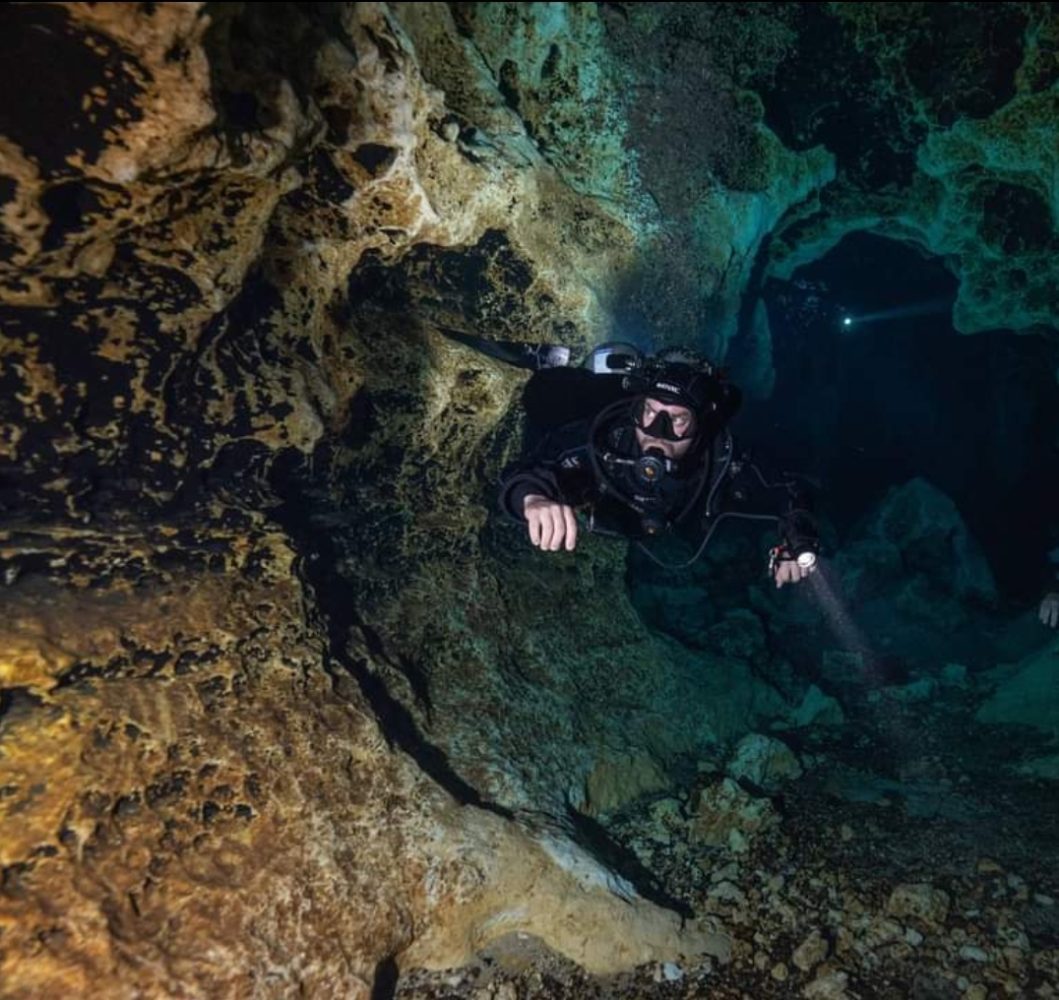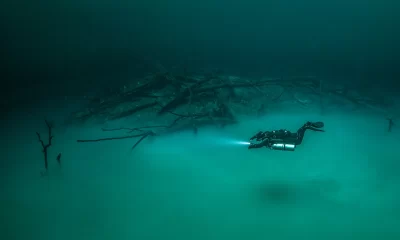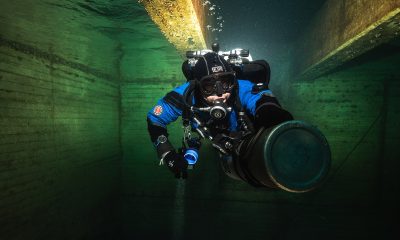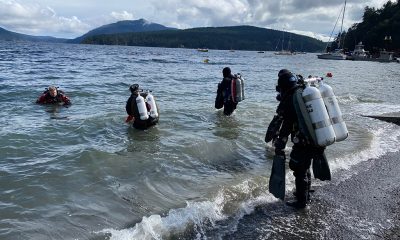Diving Safety
The Dumbest Thing I’ve Done Diving
Human factors coach Gareth Lock reminds us that we will all do something dumb while diving; it’s in our DNA. The trick is to ensure there are systems in place to prevent a hyperbaric boo-boo from becoming a catastrophe and to foster a culture where we share our mistakes without shame or blame in order to learn. Here tech diver Kyle Bourland steps up and shares a potential ‘eventful’ dive where he was lulled into making what amounted to a solo cave dive, as an open water diver. Fortunately, he survived to share the tale.

Text and Header image by Kyle Bourland
The dive trip to West Palm Beach, Florida, working with my favorite local dive shop was coming to an end, and I would have to start the 13-14 hour drive home to Memphis, Tennessee. Along my route heading north through the long state of Florida was a famous dive site known for its crystal clear waters and “open water friendly” cavern. The famous Blue Grotto, in Williston in North-central Florida, had been on my bucket list for some time. I had done some research, watched a few YouTube videos, and desperately wanted to check it out on my way home.
The day prior to our departure from West Palm Beach, I had started asking other divers on the trip if they’d like to ride back with me and buddy up for a Blue Grotto dive. Apparently nobody else seemed to share my interest in fresh water springs, as my requests for a buddy went denied. “Well, I can’t find a buddy. Guess I’ll have to skip Blue Grotto,” I stated in dismay to the instructor leading the trip.
“Just solo dive it” he said in a manner so nonchalant as to make it seem like a totally normal and acceptable thing to do.
“Really? I questioned. “But I don’t have any of the redundant equipment or training for solo diving.”
“You’re too by the book” he said as he waved off my concerns.
I was puzzled. I had been taught in class to never solo dive. But here was this instructor, a person I trusted, waving it off as no big deal.
Feeling like a complete nerd at this point I thought to myself, “am I too by the book?” “Is this a normal thing that people do all the time and I’m just making a bigger deal out of it than it really is?” “Surely, if this instructor with thousands of dives says it’s ok, it must be ok. It must be normal.”
Making The Dive
Two hundred and sixty miles northwest from West Palm, I pulled into the lot at Blue Grotto. I decided I’d try the old insta-buddy technique first. Unfortunately, the only other group was an instructor teaching an open water class, and I was not about to spend my bucket list dive kneeling on a platform watching open water students run through skills. But there was a dilemma. Per Blue Grotto policy, I had to have someone sign the waiver as my dive buddy. With pseudo confidence, I approached the instructor when he wasn’t busy and asked if he’d sign as my buddy. I didn’t conceal my intent to solo dive. In fact, I told the instructor I’d enter the water with his group, and that once we were under, I’d be out of his way, solo diving, and checking out the cavern. Without hesitation, this instructor agreed and signed my waiver.
“Huh” I thought. “I guess it really is normal. I guess I have been too by the book.”
Just as we discussed, I entered the water, waved goodbye to the instructor, and I was off. I headed down, following the left side of the cavern area until I reached a rope. I had been told that this was a cavern. I had been told that natural light could be seen from any point in this cavern. I was about to find out I had been told wrong.
Based on what I’d seen online, the rope I’d come to—and now held in my hand—went all the way to the bottom of the cavern then came back up the other side through a sort of swim-through. I proceeded downward, alone, with no redundant gas, no gas plan, no lights, and no solo training. Just a rope in one hand and horribly misplaced confidence in the other. It quickly became very dark. I could no longer see my computer, or any terrain feature in front of me. I couldn’t see my hand in front of my face. I kept swimming, expecting to see light in front of me any second from the other side of this swim through. It didn’t happen. I’ll never forget my thoughts as I stopped. “What are you doing? This is how people get killed.”
I turned around, expecting to see natural light behind me. There was nothing but pitch darkness. I was NOT in a cavern. Without ambient light, one is, by definition, in a cave. I thanked God that I had enough sense to at least maintain a hold on the rope and I turned around, followed the rope out, and reflected on my utter stupidity and all that could have gone wrong.
Post-Dive Analysis
What led an otherwise rational, safety-conscious diver to behave with such irrational disregard for basic safety rules?
In asking this question it’s easy to chalk it up to simple stupid, and readers wouldn’t be wrong in this analysis. However, that diagnosis doesn’t allow for a deeper understanding of my behavior, nor does it help to prevent future divers from making the same mistakes. The more complex answer to this question lies somewhere between normalization of deviance and the Dunning-Kruger Effect.
Normalization of deviance is a term first coined by sociologist, Diane Vaughan. She defines it as, “a process where a clearly unsafe practice comes to be considered normal if it does not immediately cause a catastrophe.” When applied to a group, an organization, or an industry, this is called social normalization of deviance.
Credit: Thehumandiver.com
This sort of social normalization of deviance can be found all around us and in nearly every aspect of life. We become accustomed to it without even knowing what it is. We may even look for it. In my own career as a firefighter it’s often said that there’s the book way to do things and then there’s how we really do things. New firefighters inevitably begin to look for these lines between book and practice. Consider driving a car. The speed limit may be 55 mph, but the custom, the norm, what is accepted is 60. And we’ve all been frustrated when stuck behind that one driver who insists on doing exactly 55 mph.
I fell victim to this phenomenon at Blue Grotto. The encounters I had with those two instructors played a crucial role in justifying my own foolish behavior. Maybe I was looking for the lines between the rule book and what really happened without even realizing it. Solo diving without training and without redundancy, despite everything I had learned in class, became “normalized”.
Next, let’s consider the Dunning-Kruger Effect. This psychological phenomenon has been discussed endlessly on scuba forums, so most divers are quite familiar with the concept. For those who aren’t, however, the Dunning-Kruger Effect is defined as a form of cognitive bias where those with low ability tend to overestimate their ability and those with high ability tend to underestimate their ability. We see this often in new divers. Minimum experience with maximum confidence is the pinnacle of Mt. Stupid and where we can probably find a vast number of accidents and near misses. If survived, the new diver hopefully walks away a bit more experienced and a lot less cocky.
The day before this dive, I had hit 100 dives. I was an “experienced” diver. By industry standards, I could have started an IDC. I felt like I could handle anything. This misplaced confidence and over-estimation of my own skill and ability, without the experience to actually back it up, proceeded me right into a risky situation.
I reflect on this now and remember it as the dumbest thing I’ve done diving. I don’t blame those two instructors. I bear full responsibility for my own actions. I knew better and chose to violate the rules. My only intent here is to share my own story and to hopefully shine a light on what I believe to be factored into the deeper psychological reasons for making such an unfortunate decision. Only through awareness of our mistakes and the distorted thinking that precipitates our actions can we improve our choices and make diving safer for everyone.
Dive Deeper:
InDepth: My Deep Dive Into The Dunning-Kruger Effect by Brendan Lund
InDepth: Drift is Normal. Being a Deviant is Normal. Here’s Why by Gareth Lock
If you had a close call experience that you’d like to share please write to us at: [email protected]

Kyle Bourland began diving in 2017, started training with GUE in 2020, and ultimately achieved his Tech 1 and Cave 2 qualifications. Professionally, he works as a firefighter/advanced EMT, and volunteers as a public safety diver in West Tennessee, USA.























































